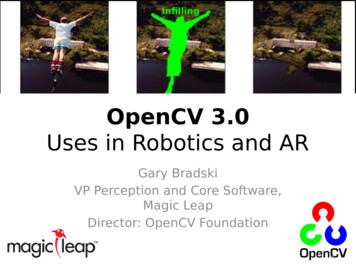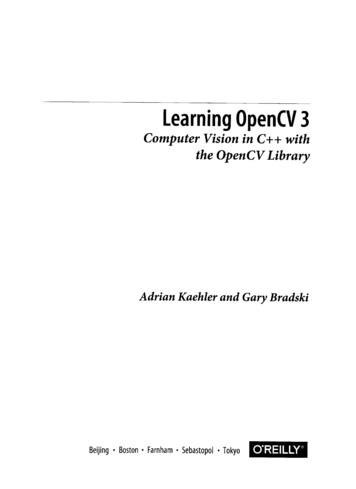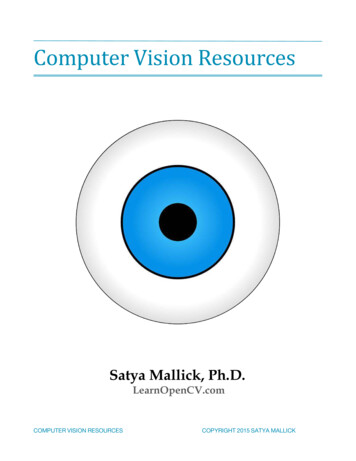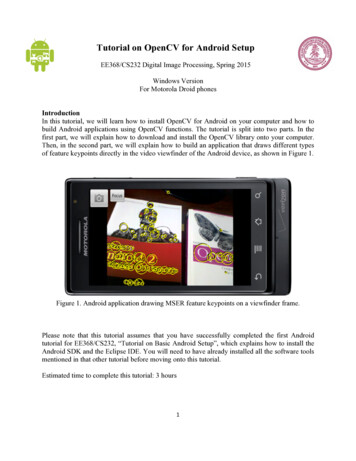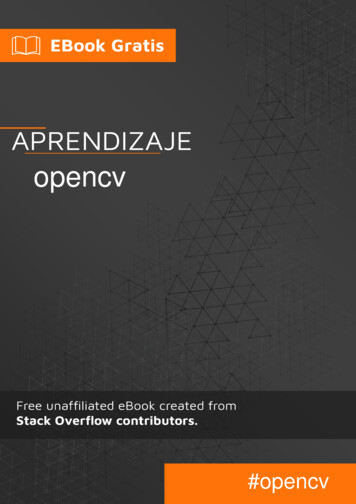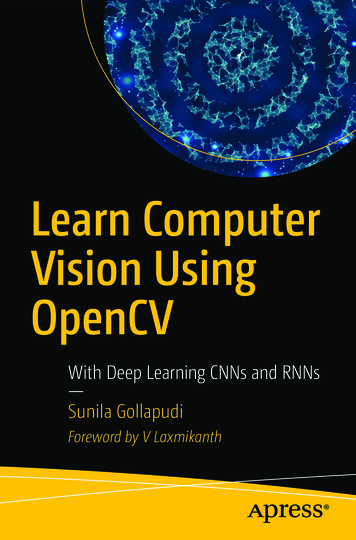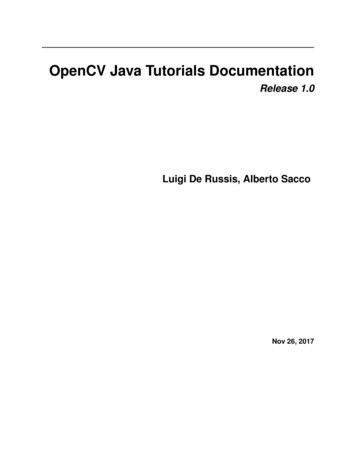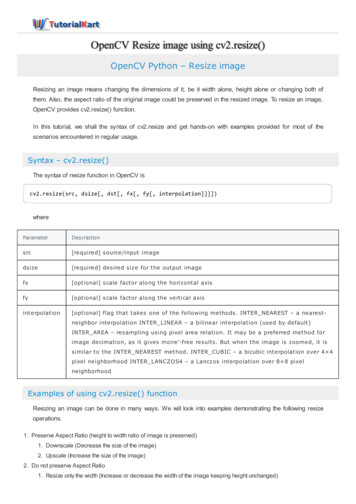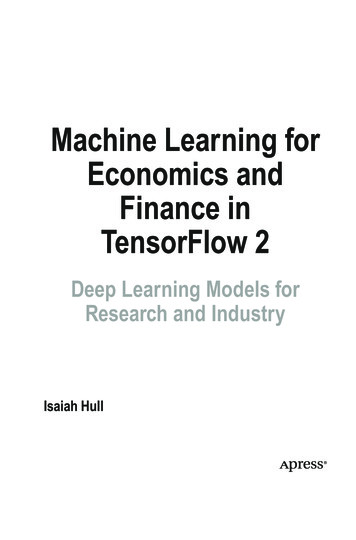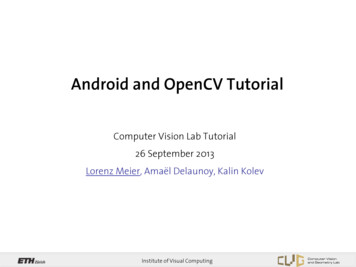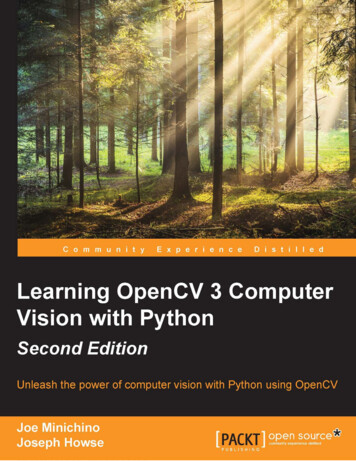
Transcription
[1]
Learning OpenCV 3 ComputerVision with PythonSecond EditionUnleash the power of computer vision with Pythonusing OpenCVJoe MinichinoJoseph HowseBIRMINGHAM - MUMBAI
Learning OpenCV 3 Computer Vision with PythonSecond EditionCopyright 2015 Packt PublishingAll rights reserved. No part of this book may be reproduced, stored in a retrievalsystem, or transmitted in any form or by any means, without the prior writtenpermission of the publisher, except in the case of brief quotations embedded incritical articles or reviews.Every effort has been made in the preparation of this book to ensure the accuracyof the information presented. However, the information contained in this book issold without warranty, either express or implied. Neither the authors, nor PacktPublishing, and its dealers and distributors will be held liable for any damagescaused or alleged to be caused directly or indirectly by this book.Packt Publishing has endeavored to provide trademark information about all of thecompanies and products mentioned in this book by the appropriate use of capitals.However, Packt Publishing cannot guarantee the accuracy of this information.First published: September 2015Production reference: 1240915Published by Packt Publishing Ltd.Livery Place35 Livery StreetBirmingham B3 2PB, UK.ISBN 978-1-78528-384-0www.packtpub.com
CreditsAuthorsJoe MinichinoProject CoordinatorMilton DsouzaJoseph HowseProofreaderReviewersSafis EditingNandan BanerjeeTian CaoBrandon CastellanoHaojian JinAdrian RosebrockCommissioning EditorAkram HussainAcquisition EditorsVivek AnantharamanPrachi BishtContent Development EditorRitika SinghTechnical EditorsNovina KewalramaniShivani Kiran MistryCopy EditorSonia CheemaIndexerMonica Ajmera MehtaGraphicsDisha HariaProduction CoordinatorArvindkumar GuptaCover WorkArvindkumar Gupta
About the AuthorsJoe Minichino is a computer vision engineer for Hoolux Medical by day and adeveloper of the NoSQL database LokiJS by night. On weekends, he is a heavy metalsinger/songwriter. He is a passionate programmer who is immensely curious aboutprogramming languages and technologies and constantly experiments with them. AtHoolux, Joe leads the development of an Android computer vision-based advertisingplatform for the medical industry.Born and raised in Varese, Lombardy, Italy, and coming from a humanisticbackground in philosophy (at Milan's Università Statale), Joe has spent his last11 years living in Cork, Ireland, which is where he became a computer sciencegraduate at the Cork Institute of Technology.I am immensely grateful to my partner, Rowena, for alwaysencouraging me, and also my two little daughters for inspiringme. A big thank you to the collaborators and editors of this book,especially Joe Howse, Adrian Roesbrock, Brandon Castellano, theOpenCV community, and the people at Packt Publishing.Joseph Howse lives in Canada. During the winters, he grows his beard, whilehis four cats grow their thick coats of fur. He loves combing his cats every day andsometimes, his cats also pull his beard.He has been writing for Packt Publishing since 2012. His books include OpenCV forSecret Agents, OpenCV Blueprints, Android Application Programming with OpenCV 3,OpenCV Computer Vision with Python, and Python Game Programming by Example.When he is not writing books or grooming his cats, he provides consulting,training, and software development services through his company,Nummist Media (http://nummist.com).
About the ReviewersNandan Banerjee has a bachelor's degree in computer science and a master'sin robotics engineering. He started working with Samsung Electronics right aftergraduation. He worked for a year at its R&D centre in Bangalore. He also worked inthe WPI-CMU team on the Boston Dynamics' robot, Atlas, for the DARPA RoboticsChallenge. He is currently working as a robotics software engineer in the technologyorganization at iRobot Corporation. He is an embedded systems and roboticsenthusiast with an inclination toward computer vision and motion planning. He hasexperience in various languages, including C, C , Python, Java, and Delphi. Healso has a substantial experience in working with ROS, OpenRAVE, OpenCV, PCL,OpenGL, CUDA and the Android SDK.I would like to thank the author and publisher for coming out withthis wonderful book.Tian Cao is pursuing his PhD in computer science at the University of NorthCarolina in Chapel Hill, USA, and working on projects related to image analysis,computer vision, and machine learning.I dedicate this work to my parents and girlfriend.
Brandon Castellano is a student from Canada pursuing an MESc in electricalengineering at the University of Western Ontario, City of London, Canada. Hereceived his BESc in the same subject in 2012. The focus of his research is in parallelprocessing and GPGPU/FPGA optimization for real-time implementations of imageprocessing algorithms. Brandon also works for Eagle Vision Systems Inc., focusingon the use of real-time image processing for robotics applications.While he has been using OpenCV and C for more than 5 years, he has also beenadvocating the use of Python frequently in his research, most notably, for its rapidspeed of development, allowing low-level interfacing with complex systems. This isevident in his open source projects hosted on GitHub, for example, PySceneDetect,which is mostly written in Python. In addition to image/video processing, hehas also worked on implementations of three-dimensional displays as well as thesoftware tools to support the development of such displays.In addition to posting technical articles and tutorials on his website(http://www.bcastell.com), he participates in a variety of both open andclosed source projects and contributes to GitHub under the username Breakthrough(http://www.github.com/Breakthrough). He is an active member of the SuperUser and Stack Overflow communities (under the name Breakthrough), and can becontacted directly via his website.I would like to thank all my friends and family for their patienceduring the past few years (especially my parents, Peter and Lori,and my brother, Mitchell). I could not have accomplished everythingwithout their continued love and support. I can't ever thankeveryone enough.I would also like to extend a special thanks to all of the developersthat contribute to open source software libraries, specificallyOpenCV, which help bring the development of cutting-edgesoftware technology closer to all the software developers around theworld, free of cost. I would also like to thank those people who helpwrite documentation, submit bug reports, and write tutorials/books(especially the author of this book!). Their contributions are vitalto the success of any open source project, especially one that is asextensive and complex as OpenCV.
Haojian Jin is a software engineer/researcher at Yahoo! Labs, Sunnyvale, CA. Helooks primarily at building new systems of what's possible on commodity mobiledevices (or with minimum hardware changes). To create things that don't existtoday, he spends large chunks of his time playing with signal processing, computervision, machine learning, and natural language processing and using them ininteresting ways. You can find more about him at http://shift-3.com/Adrian Rosebrock is an author and blogger at http://www.pyimagesearch.com/.He holds a PhD in computer science from the University of Maryland, BaltimoreCounty, USA, with a focus on computer vision and machine learning.He has consulted for the National Cancer Institute to develop methods thatautomatically predict breast cancer risk factors using breast histology images. He hasalso authored a book, Practical Python and OpenCV (http://pyimg.co/x7ed5), on theutilization of Python and OpenCV to build real-world computer vision applications.
www.PacktPub.comSupport files, eBooks, discount offers, and moreFor support files and downloads related to your book, please visit www.PacktPub.com.Did you know that Packt offers eBook versions of every book published, with PDFand ePub files available? You can upgrade to the eBook version at www.PacktPub.comand as a print book customer, you are entitled to a discount on the eBook copy. Get intouch with us at service@packtpub.com for more details.At www.PacktPub.com, you can also read a collection of free technical articles, signup for a range of free newsletters and receive exclusive discounts and offers on Packtbooks and ion/packtlibDo you need instant solutions to your IT questions? PacktLib is Packt's online digitalbook library. Here, you can search, access, and read Packt's entire library of books.Why subscribe? Fully searchable across every book published by Packt Copy and paste, print, and bookmark content On demand and accessible via a web browserFree access for Packt account holdersIf you have an account with Packt at www.PacktPub.com, you can use this to accessPacktLib today and view 9 entirely free books. Simply use your login credentials forimmediate access.
Table of ContentsPrefaceChapter 1: Setting Up OpenCVChoosing and using the right setup toolsInstallation on WindowsUsing binary installers (no support for depth cameras)Using CMake and compilersInstalling on OS XUsing MacPorts with ready-made packagesUsing MacPorts with your own custom packagesUsing Homebrew with ready-made packages (no support for depth cameras)Using Homebrew with your own custom packagesvii1223478101213Installation on Ubuntu and its derivatives13Installation on other Unix-like systemsInstalling the Contrib modulesRunning samplesFinding documentation, help, and updatesSummary1516161819Using the Ubuntu repository (no support for depth cameras)Building OpenCV from a sourceChapter 2: Handling Files, Cameras, and GUIsBasic I/O scriptsReading/writing an image fileConverting between an image and raw bytesAccessing image data with numpy.arrayReading/writing a video fileCapturing camera framesDisplaying images in a windowDisplaying camera frames in a windowProject Cameo (face tracking and image manipulation)[i]141421212224262829313234
Table of ContentsCameo – an object-oriented designAbstracting a video stream with managers.CaptureManagerAbstracting a window and keyboard with managers.WindowManagerApplying everything with cameo.CameoSummaryChapter 3: Processing Images with OpenCV 3Converting between different color spacesA quick note on BGRThe Fourier TransformHigh pass filterLow pass filterCreating modulesEdge detectionCustom kernels – getting convolutedModifying the applicationEdge detection with CannyContour detectionContours – bounding box, minimum area rectangle,and minimum enclosing circleContours – convex contours and the Douglas-Peucker algorithmLine and circle detectionLine detectionCircle detectionDetecting 06262636465Chapter 4: Depth Estimation and Segmentation67Chapter 5: Detecting and Recognizing Faces89Creating modulesCapturing frames from a depth cameraCreating a mask from a disparity mapMasking a copy operationDepth estimation with a normal cameraObject segmentation using the Watershed and GrabCut algorithmsExample of foreground detection with GrabCutImage segmentation with the Watershed algorithmSummaryConceptualizing Haar cascadesGetting Haar cascade dataUsing OpenCV to perform face detectionPerforming face detection on a still image[ ii ]67687172748082848790919192
Table of ContentsPerforming face detection on a videoPerforming face recognitionGenerating the data for face recognitionRecognizing facesPreparing the training dataLoading the data and recognizing facesPerforming an Eigenfaces recognitionPerforming face recognition with FisherfacesPerforming face recognition with LBPHDiscarding results with confidence scoreSummaryChapter 6: Retrieving Images and SearchingUsing Image DescriptorsFeature detection algorithmsDefining featuresDetecting features – eature extraction and description using DoG and SIFT113Feature extraction and detection using Fast Hessian and SURFORB feature detection and feature matching117120Feature matching with ORBUsing K-Nearest Neighbors matchingFLANN-based matchingFLANN matching with homographyA sample application – tattoo forensics122125126130133Anatomy of a keypointFASTBRIEFBrute-Force matchingSaving image descriptors to fileScanning for matchesSummaryChapter 7: Detecting and Recognizing ObjectsObject detection and recognition techniquesHOG descriptorsThe scale issueThe location issueNon-maximum (or non-maxima) suppressionSupport vector machinesPeople detectionCreating and training an object detectorBag-of-wordsBOW in computer visionDetecting carsWhat did we just 9149150153155[ iii ]
Table of ContentsSVM and sliding windows160Example – car detection in a sceneDude, where's my car?161171Summary175Chapter 8: Tracking ObjectsDetecting moving objectsBasic motion detectionBackground subtractors – KNN, MOG2, and GMGMeanshift and CAMShiftColor histogramsThe calcHist functionThe calcBackProject functionIn summaryBack to the codeCAMShiftThe Kalman filterPredict and updateAn exampleA real-life example – tracking pedestriansThe application workflowA brief digression – functional versus object-oriented programmingThe Pedestrian classThe main programWhere do we go from 200200202205207SummaryChapter 9: Neural Networks with OpenCV – an IntroductionArtificial neural networksNeurons and perceptronsThe structure of an ANNNetwork layers by exampleThe input layerThe output layerThe hidden layerANNs in OpenCVANN-imal classificationTraining epochsHandwritten digit recognition with ANNsMNIST – the handwritten digit databaseCustomized training dataThe initial parametersThe input layerThe hidden layerThe output layer[ iv 22223223
Table of ContentsTraining epochsOther parametersMini-librariesThe main filePossible improvements and potential o boldly go 235235Potential applicationsIndex235237[v]
PrefaceOpenCV 3 is a state-of-the-art computer vision library that is used for a varietyof image and video processing operations. Some of the more spectacular andfuturistic features, such as face recognition or object tracking, are easily achievablewith OpenCV 3. Learning the basic concepts behind computer vision algorithms,models, and OpenCV's API will enable the development of all sorts of real-worldapplications, including security and surveillance tools.Starting with basic image processing operations, this book will take you througha journey that explores advanced computer vision concepts. Computer vision is arapidly evolving science whose applications in the real world are exploding, so thisbook will appeal to computer vision novices as well as experts of the subject whowant to learn about the brand new OpenCV 3.0.0.What this book coversChapter 1, Setting Up OpenCV, explains how to set up OpenCV 3 with Python ondifferent platforms. It will also troubleshoot common problems.Chapter 2, Handling Files, Cameras, and GUIs, introduces OpenCV's I/O functionalities.It will also discuss the concept of a project and the beginnings of an object-orienteddesign for this project.Chapter 3, Processing Images with OpenCV 3, presents some techniques required toalter images, such as detecting skin tone in an image, sharpening an image, markingcontours of subjects, and detecting crosswalks using a line segment detector.Chapter 4, Depth Estimation and Segmentation, shows you how to use data from adepth camera to identify foreground and background regions, such that we canlimit an effect to only the foreground or background.[ vii ]
PrefaceChapter 5, Detecting and Recognizing Faces, introduces some of OpenCV's facedetection functionalities, along with the data files that define particular typesof trackable objects.Chapter 6, Retrieving Images and Searching Using Image Descriptors, shows how todetect the features of an image with the help of OpenCV and make use of themto match and search for images.Chapter 7, Detecting and Recognizing Objects, introduces the concept of detecting andrecognizing objects, which is one of the most common challenges in computer vision.Chapter 8, Tracking Objects, explores the vast topic of object tracking, which is theprocess of locating a moving object in a movie or video feed with the help of a camera.Chapter 9, Neural Networks with OpenCV – an Introduction, introduces you to ArtificialNeural Networks in OpenCV and illustrates their usage in a real-life application.What you need for this bookYou simply need a relatively recent computer, as the first chapter will guideyou through the installation of all the necessary software. A webcam is highlyrecommended, but not necessary.Who this book is forThis book is aimed at programmers with working knowledge of Python as well aspeople who want to explore the topic of computer vision using the OpenCV library.No previous experience of computer vision or OpenCV is required. Programmingexperience is recommended.ConventionsIn this book, you will find a number of text styles that distinguish between differentkinds of information. Here are some examples of these styles and an explanation oftheir meaning.Code words in text, database table names, folder names, filenames, file extensions,pathnames, dummy URLs, user input, and Twitter handles are shown as follows:"We can include other contexts through the use of the include directive."[ viii ]
PrefaceA block of code is set as follows:import cv2import numpy as npimg cv2.imread('images/chess board.png')gray cv2.cvtColor(img, cv2.COLOR BGR2GRAY)gray np.float32(gray)dst cv2.cornerHarris(gray, 2, 23, 0.04)When we wish to draw your attention to a particular part of a code block, therelevant lines or items are set in bold:img cv2.imread('images/chess board.png')gray cv2.cvtColor(img, cv2.COLOR BGR2GRAY)gray np.float32(gray)dst cv2.cornerHarris(gray, 2, 23, 0.04)Any command-line input or output is written as follows:mkdir build && cd buildcmake D CMAKE BUILD TYPE Release -DOPENCV EXTRA MODULES PATH opencvcontrib /modules D CMAKE INSTALL PREFIX /usr/local .makeNew terms and important words are shown in bold. Words that you see on thescreen, for example, in menus or dialog boxes, appear in the text like this: " OnWindows Vista / Windows 7 / Windows 8, click on the Start menu."Warnings or important notes appear in a box like this.Tips and tricks appear like this.[ ix ]
PrefaceReader feedbackFeedback from our readers is always welcome. Let us know what you think aboutthis book—what you liked or disliked. Reader feedback is important for us as it helpsus develop titles that you will really get the most out of.To send us general feedback, simply e-mail feedback@packtpub.com, and mentionthe book's title in the subject of your message.If there is a topic that you have expertise in and you are interested in either writingor contributing to a book, see our author guide at www.packtpub.com/authors.Customer supportNow that you are the proud owner of a Packt book, we have a number of things tohelp you to get the most from your purchase.Downloading the example codeYou can download the example code files from your account at http://www.packtpub.com for all the Packt Publishing books you have purchased. If youpurchased this book elsewhere, you can visit http://www.packtpub.com/supportand register to have the files e-mailed directly to you.ErrataAlthough we have taken every care to ensure the accuracy of our content, mistakesdo happen. If you find a mistake in one of our books—maybe a mistake in the text orthe code—we would be grateful if you could report this to us. By doing so, you cansave other readers from frustration and help us improve subsequent versions of thisbook. If you find any errata, please report them by visiting http://www.packtpub.com/submit-errata, selecting your book, clicking on the Errata Submission Formlink, and entering the details of your errata. Once your errata are verified, yoursubmission will be accepted and the errata will be uploaded to our website or addedto any list of existing errata under the Errata section of that title.To view the previously submitted errata, go to https://www.packtpub.com/books/content/support and enter the name of the book in the search field. The requiredinformation will appear under the Errata section.[x]
PrefacePiracyPiracy of copyrighted material on the Internet is an ongoing problem across allmedia. At Packt, we take the protection of our copyright and licenses very seriously.If you come across any illegal copies of our works in any form on the Internet, pleaseprovide us with the location address or website name immediately so that we canpursue a remedy.Please contact us at copyright@packtpub.com with a link to the suspectedpirated material.We appreciate your help in protecting our authors and our ability to bring youvaluable content.QuestionsIf you have a problem with any aspect of this book, you can contact us atquestions@packtpub.com, and we will do our best to address the problem.[ xi ]
Setting Up OpenCVYou picked up this book so you may already have an idea of what OpenCV is.Maybe, you heard of Sci-Fi-sounding features, such as face detection, and gotintrigued. If this is the case, you've made the perfect choice. OpenCV stands forOpen Source Computer Vision. It is a free computer vision library that allows youto manipulate images and videos to accomplish a variety of tasks from displayingthe feed of a webcam to potentially teaching a robot to recognize real-life objects.In this book, you will learn to leverage the immense potential of OpenCV with thePython programming language. Python is an elegant language with a relativelyshallow learning curve and very powerful features. This chapter is a quick guide tosetting up Python 2.7, OpenCV, and other related libraries. After setup, we also lookat OpenCV's Python sample scripts and documentation.If you wish to skip the installation process and jump right into action,you can download the virtual machine (VM) I've made available athttp://techfort.github.io/pycv/.This file is compatible with VirtualBox, a free-to-use virtualizationapplication that lets you build and run VMs. The VM I've built isbased on Ubuntu Linux 14.04 and has all the necessary softwareinstalled so that you can start coding right away.This VM requires at least 2 GB of RAM to run smoothly, so make surethat you allocate at least 2 (but, ideally, more than 4) GB of RAM tothe VM, which means that your host machine will need at least 6 GBof RAM to sustain it.[1]
Setting Up OpenCVThe following related libraries are covered in this chapter: NumPy: This library is a dependency of OpenCV's Python bindings.It provides numeric computing functionality, including efficient arrays. SciPy: This library is a scientific computing library that is closely related toNumPy. It is not required by OpenCV, but it is useful for manipulating datain OpenCV images. OpenNI: This library is an optional dependency of OpenCV. It adds thesupport for certain depth cameras, such as Asus XtionPRO. SensorKinect: This library is an OpenNI plugin and optional dependency ofOpenCV. It adds support for the Microsoft Kinect depth camera.For this book's purposes, OpenNI and SensorKinect can be considered optional.They are used throughout Chapter 4, Depth Estimation and Segmentation, but arenot used in the other chapters or appendices.This book focuses on OpenCV 3, the new major release of theOpenCV library. All additional information about OpenCV isavailable at http://opencv.org, and its documentation isavailable at http://docs.opencv.org/master.Choosing and using the right setup toolsWe are free to choose various setup tools, depending on our operating system andhow much configuration we want to do. Let's take an overview of the tools forWindows, Mac, Ubuntu, and other Unix-like systems.Installation on WindowsWindows does not come with Python preinstalled. However, installation wizards areavailable for precompiled Python, NumPy, SciPy, and OpenCV. Alternatively, wecan build from a source. OpenCV's build system uses CMake for configuration andeither Visual Studio or MinGW for compilation.If we want support for depth cameras, including Kinect, we should first installOpenNI and SensorKinect, which are available as precompiled binaries withinstallation wizards. Then, we must build OpenCV from a source.The precompiled version of OpenCV does not offer supportfor depth cameras.[2]
Chapter 1On Windows, OpenCV 2 offers better support for 32-bit Python than 64-bit Python;however, with the majority of computers sold today being 64-bit systems, ourinstructions will refer to 64-bit. All installers have 32-bit versions available from thesame site as the 64-bit.Some of the following steps refer to editing the system's PATH variable. This task canbe done in the Environment Variables window of Control Panel.1. On Windows Vista / Windows 7 / Windows 8, click on the Start menu andlaunch Control Panel. Now, navigate to System and Security System Advanced system settings. Click on the Environment Variables button.2. On Windows XP, click on the Start menu and navigate to Control Panel System. Select the Advanced tab. Click on the Environment Variables button.3. Now, under System variables, select Path and click on the Edit button.4. Make changes as directed.5. To apply the changes, click on all the OK buttons (until we are back in themain window of Control Panel).6. Then, log out and log back in (alternatively, reboot).Using binary installers (no support for depthcameras)You can choose to install Python and its related libraries separately if you prefer;however, there are Python distributions that come with installers that will set up theentire SciPy stack (which includes Python and NumPy), which make it very trivial toset up the development environment.One such distribution is Anaconda Python (downloadable athttp://09c8d0b2229f813c1b93 om/Anaconda-2.1.0 Windows-x86 64.exe). Once the installer isdownloaded, run it and remember to add the path to the Anaconda installation toyour PATH variable following the preceding procedure.[3]
Setting Up OpenCVHere are the steps to set up Python7, NumPy, SciPy, and OpenCV:1. Download and install the 32-bit Python 2.7.9 from .9.amd64.msi.2. Download and install NumPy 1.6.2 from http://www.lfd.uci.edu/ perpackpython2.7.exe/download (note that installing NumPy on Windows 64-bitis a bit tricky due to the lack of a 64-bit Fortran compiler on Windows, whichNumPy depends on. The binary at the preceding link is unofficial).3. Download and install SciPy 11.0 from http://www.lfd.uci.edu/ jects/scipy/files/scipy/0.11.0/scipy-0.11.0 win32-superpack-python2.7.exe/download(this is the same as NumPy and these are community installers).4. Download the self-extracting ZIP of OpenCV 3.0.0 from https://github.com/Itseez/opencv. Run this ZIP, and when prompted, enter a destinationfolder, which we will refer to as unzip destination . A subfolder, unzip destination \opencv, is created.5. Copy unzip destination \opencv\build\python\2.7\cv2.pyd to C:\Python2.7\Lib\site-packages (assuming that we had installed Python 2.7to the default location). If you installed Python 2.7 with Anaconda, use theAnaconda installation folder instead of the default Python installation. Now,the new Python installation can find OpenCV.6. A final step is necessary if we want Python scripts to run using the newPython installation by default. Edit the system's PATH variable and append;C:\Python2.7 (assuming that we had installed Python 2.7 to the defaultlocation) or your Anaconda installation folder. Remove any previous Pythonpaths, such as ;C:\Python2.6. Log out and log back in (alternatively, reboot).Using CMake and compilersWindows does not come with any compilers or CMake. We need to install them.If we want support for depth cameras, including Kinect, we also need to installOpenNI and SensorKinect.[4]
Chapter 1Let's assume that we have already installed 32-bit Python 2.7, NumPy, and SciPyeither from binaries (as described previously) or from a source. Now, we canproceed with installing compilers and CMake, optionally installing OpenNI andSensorKinect, and then building OpenCV from the source:1. Download and install CMake 3.1.2 from x86.exe. When running the installer, selecteither Add CMake to the system PATH for all users or Add CMake tothe system PATH for current user. Don't worry about the fact that a 64-bitversion of CMake is not available CMake is only a configuration tool anddoes not perform any compilations itself. Instead, on Windows, it createsproject files that can be opened with Visual Studio.2. Download and install Microsoft Visual Studio 2013 (the Desktop edition ifyou are working on Windows 7) from er-offers-vs.aspx?slcid 0x409&type webor MinGW.Note that you will need to sign in with your Microsoft account and if youdon't have one, you can create one on the spot. Install the software andreboot after installation is complete.For MinGW, get the installer from ler/mingw-get-setup.exe/download and t-inst-20120426.exe/download.When running the installer, make sure that the destination path does notcontain spaces and that the optional C compiler is inclu
Learning OpenCV 3 Computer Vision with Python Second Edition Unleash the power of computer vision with Python using OpenCV Joe Minichino Joseph Howse . OpenCV, which help bring the development of cutting-edge software technology closer to all the software developers around the world, free of cost. .
